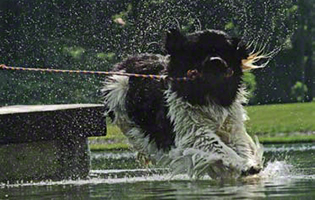by Jenny Zablotny, DVM
What food to feed your pets has been a dilemma since large scale pet food manufacturing became the norm. We’ve come a long way from horsemeat and garbage! Despite many claims to the contrary, there isn’t one, perfect food. Marketing is king. They aren’t selling food to dogs and cats. Companies are selling product to human consumers and it is big business. Buzz words like holistic, ancient, raw-infused, grain free are all designed to attract buyers. The vast choice of available products boggles even this veterinarian’s mind. How does the average pet owner make an informed decision on an appropriate diet?
First, you. We all take cost, availability, stool quality and whether the dog eats it into account when feeding a food. Many decisions to switch are because of messy stools or the dog won’t eat it. Personally, I want to be able to buy a bag bigger than 30 pounds and I want to purchase it anywhere. I also demand good coats and stools and have been fortunate to have found a food that satisfies these criteria. There isn’t anything wrong with taking your budget into consideration when choosing a food. Are ultra-premium priced foods worth it? Maybe. Look to the ingredients on the label.
Second, your veterinarian. If your vet can’t find anything nutritionally wrong with your dog, then your food choice is appropriate. Many vets can’t endorse raw because of infectious disease concerns and lack of properly balanced diets. Grain free diets may have an association with serious heart conditions. Proceed with caution if you opt for grain free. However, the number one, food-related issue seen in dogs (and cats) today is obesity. You may need a food that is lower in calories. That number can be found on the label.
Third, your breeder. They will know what works well on their dogs. Perhaps they are recommending an all lifestages food for your puppy. How do you know if a food is all lifestages? You guessed it! The label.
So now a trip to the pet food store to start comparing labels. The problem with labels and packaging in general is teasing out the meat from the marketing. Are those colorful fruits and veggies on the label actually in the food? How much beef is really in “beef dinner”? The resources below contain solid advice on how to read pet food labels with an eye towards accuracy and not just the marketing. You may even discover a few things about the food you are feeding or ones you have considered!
Pet Food Institute. LOTS of information on labels and industry regulations with an informative blog.
American Kennel Club sheet on pet food labels.
The Association of American Feed Control Officials (AAFCO) deep dive into ingredients.
Very good, in-depth look at labels and ingredients and label claims by Savannah Welna, Cert. ACN
The dizzying array of pet food choices is enough to flummox even a trained nutritionist. Learning how to read a pet food label will allow you to compare apples to apples. Avoid the hype and use the label to your advantage to make an informed choice of what to feed your Newf.

